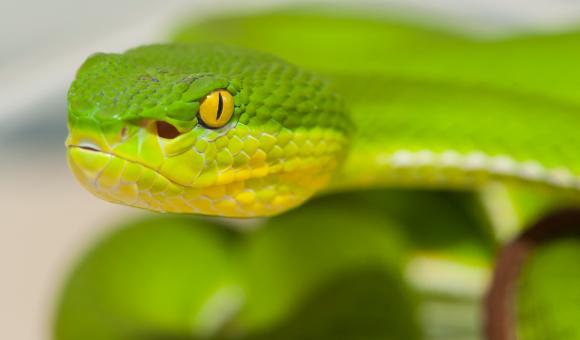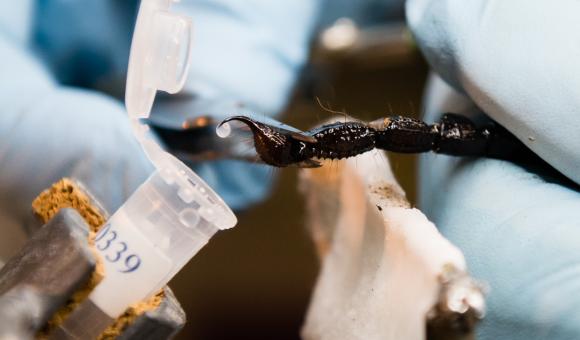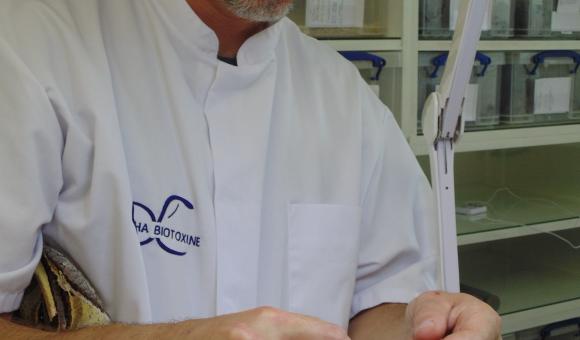
In constant contact with pharmaceutical companies, biotechs, and academic and private research centres, Alphabiotoxine is totally committed to collecting venom.
These venoms are taken from snakes, scorpions, spiders, hymenoptra (bees, wasps, hornets...), amphibians (frogs, toads, salamanders...) or large lizards from Central America (Helodermes), Asia and Africa (Goannas)... and also jellyfish, sea anemones, coral, fish and cones (sea snails) to enable preparing the drugs of the future.
The business owners’ routine is more than just an office, chair and laptop Some have added an exotic touch in a very rigorous environment with a high degree of accuracy at all times. Although today, running the laboratory is under Dr. Aude Violette’s management Rudy Fourmy, always there, remains the founder of Alphabiotoxine, for whom it all started in 2009. “The idea came to me 10 years ago. Historically, venoms were produced for manufacturing anti-venom serums during the 1980s, a few laboratories produced venoms for research on new molecules essentially for therapeutic use. The main problem was the low quantity of venom available. For example to obtain the 5 gr of scorpion venom needed for the research work required a huge amount of animals. Several hundred little black widows are needed to harvest just a few milligrams of venom. “ Fortunately techniques have developed. Now, a few milligrams are enough to do the same work. This opens the investigation field to many new species.
Animal well-being, diversification and quality
Within the company located in Montrœul-au-Bois at Hainaut, raising animals and extracting venom is done in accordance with processes which respect animal well-being. «We make a point, as far as possible, of respecting our animals’ well-being, who we consider more as colleagues than laboratory material. So the animals are kept individually in order to monitor them in the best way possible, including their food and growth. The animals receive a varied and nutritious diet. Rats, mice, fish or insects are on the menu. Note that the prey is never distributed live, a question of ethics. The number of animals present fluctuates. The maximum capacity is 200 snakes and 3000 invertebrates in total depending on sizes (scorpions, spiders...). “
In order to ensure the animals’ comfort as well, the venom is sometimes collected under anaesthesia, and sometimes using electrical or osmotic stimulants. After harvesting, depending on the customers’ requirements, the venoms are either dried, freeze dried or crystallised in vacuo. “At the end of the last century, the analysis techniques for venom developed and specific requests started to be expressed. With a friend, we decided that there was a place available in this niche market. Thinking out and developing the Alphabiotoxine concept took a long time, but when it became clear that we were on our way, we went for it. So we specialised in producing small quantities of venom but offering a very diversified collection, venom from marine organisms for example. Over time, we have really acquired a know-how in original productions. We were self-financed and that took more time and still does. But is this field, you need to be patient, whereas today there is no doubt we would have launched crowd funding. Currently, we export more than 90*% of our production, 70% of which to Europe. Only a little over 5% is reserved for Belgium”, adds Rudy Fourmy.
Frozen at a very low temperature and most often freeze dried, the venoms produced in our laboratories are stored at -18°C to guarantee a product of excellent quality. “Traceability is one of our key commitments. It is possible, in fact, to trace and document the venom’s history from its extraction to its distribution going through all the production stages. “
High-profile customers
Alphabiotoxine is one of the most successful companies in the field, with a catalogue of more than 300 references. It is capable of meeting any specific request, (rare species, hybrids, siblings, blood plasma, venom on specific medium, bases for mother tincture, etc.): “In particular we have major pharmaceutical groups and biotechs as customers, but also universities. Our venoms are primarily destined for medical research, for producing diagnostic tests in particular. “
Although originally, requests rolled in for venoms from scorpions, spiders, Bufonidae (frogs-toads), Heloderma ( large lizards from Central America) and hymenoptra aculeatus (wasps, bees, hornets, bumblebees), nowadays marine organisms such as corals, anemones, jellyfish, octopus and holothurians provide new opportunities for venom extraction.
This is why many large research groups have turned to Alphabiotoxine.
Work recognised by Europe
Apart from research, economic issues are very important, and, a few years ago, the European Union was totally right in financing research programmes in which Alphabiotoxine participates (cancer, diabetes, haemostasis, nerve transmission...) as a supplier or partner. "With the Venomics programme we were the main supplier for the European project. That was a long-term undertaking. On the 200 species studied, 25,000 molecules were isolated, and 4 or 5 are already the subject of in-depth research. “ As a reminder, the Horizon 2020 programme supports research and innovation in Europe thanks to an 80 billion Euro budget for the 2014-2020 period. Among the projects financed, Venomics is an ambitious study aimed at transforming venom from various species into medical remedies.
Safety and delivery
Security is also an important aspect of the activity. These animals are nevertheless dangerous and there is no place for distraction. So all the tasks have protocols in order to reduce the risk as much as possible. Raising the animals is monitored and the staff made up of about ten employees undergo on-going, thorough and in-depth training on handling these animals and what to do in case of accident. “Our safety policy and our vigilance have enabled serious accidents to be avoided. Just one emergency intervention has occurred in 10 years whereas in this type of operation, in general, an accident occurs every 18 to 24 months! This time is was very close to a disaster but these are the risks inherent to the profession…»
“Transporting venom once the order has been completed also represents a complex task. The products are packaged in sealed vials and are dispatched with the utmost discretion”, states Rudy Fourmy.
Currently, one of the projects on which the company is working is a molecule extracted from cane toad venom for developing a diagnostic test for eclampsia (an illness at the end of pregnancy). This research work is being done among others in collaboration with the Universities of Mons and Liège, where new analysis equipment has recently been acquired within a major mass spectrometry platform (Bio Profiling and MS Quanta).
By Vincent Liévin
Read the other articles in the W+B review no. 143 by clicking here








